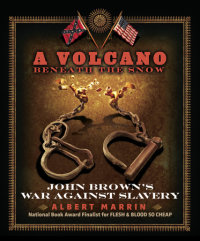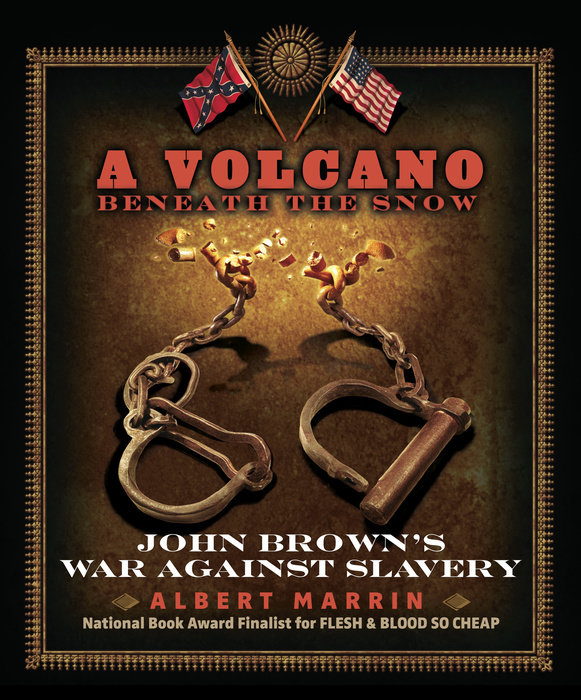A Volcano Beneath the Snow
John Brown is a man of many legacies, from hero, freedom fighter, and martyr, to liar, fanatic, and "the father of American terrorism." Some have said that it was his seizure of the arsenal at Harper's Ferry that rendered the Civil War inevitable.
Deeply religious, Brown believed that God had chosen him to right the wrong of slavery. He was willing to kill and die for something modern Americans unanimously agree was a just cause. And yet he was a religious fanatic and a staunch believer in "righteous violence," an unapologetic committer of domestic terrorism. Marrin brings 19th-century issues into the modern arena with ease and grace in a book that is sure to spark discussion.
An Excerpt fromA Volcano Beneath the Snow
John Brown was born in Torrington, Connecticut, on May 9, 1800, five months after the death of George Washington. If you could step into a time machine and return to that year, you would hardly recognize the United States. It was very young: only twenty-four years old if we reckon its birth from the Declaration of Independence, eleven if we reckon it by the date the Constitution went into effect. The Union had grown to sixteen states from the original thirteen colonies. It had 5,308,483 people, of whom 893,602 were slaves brought from Africa or born to their descendants.1
Also in 1800, a slave called “General” Gabriel led a rebellion in Virginia, the first large slave uprising in American history. It failed when another slave revealed the plot, and its leaders were executed. “I have nothing more to offer,” one of Gabriel’s men told the judge who sentenced them, “than what General Washington would have had to offer, had he been taken by the British and put on trial. I have adventured my life in endeavoring to obtain the liberty of [enslaved people], and am a willing sacrifice in their cause.” Meanwhile, Nat Turner, destined to be a more famous rebel leader, was born that same year in Virginia.2
Two out of three Americans, white and black, stayed within fifty miles of the Atlantic coast. The vast majority lived in villages or small towns, or on family farms; only 6 percent lived in towns and cities of more than 2,500 people. The nation’s largest city, New York, had a population of about 60,500 in 1800. Philadelphia, the capital city, came next with 41,000, and Baltimore was a distant third with 26,500 inhabitants. Called “walking cities,” these were small enough to allow their inhabitants reach any place on foot in under an hour. Places like Detroit, Chicago, and Cleveland were still frontier forts surrounded by stockades, walls of pointed logs.3
That summer, the federal government moved from Philadelphia to Washington City in the District of Columbia--or Washington, D.C.--at the time a one-hundred-square-mile tract of land along the Potomac River between Maryland and Virginia. It was a leisurely move, because there was not much to do during the hot season. Besides, the Constitution strictly limited the powers of the federal government. It regulated trade between the states, ran the postal system, supported the army and navy, and dealt with foreign countries. There was no income tax, and, unlike today, the federal government had no power in matters of health, education, the environment, safety, local transportation, or labor relations.
Washington City was hardly a city at all. Nearby marshes filled it with the stench of decaying plants. In warm weather, mosquitoes rose from the marshes in clouds, spreading diseases. For want of exact scientific names, residents lumped these together as “fevers.” Now-famous landmarks like the U.S. Capitol were still unfinished. Gangs of slave artisans worked on government buildings six days a week. Contractors rented each carpenter, stonemason, plasterer, and painter from his master for between 25 and 50 cents a day. Blacks made nearly all the millions of bricks used for the interior walls of our great public buildings.
Workers rushed to complete President’s House, the original name for what we call the White House. Still, much remained to be done when John Adams arrived early in November. The second president wrote his wife, Abigail, due to come later, that he hoped “none but honest and wise men [shall] ever rule under this roof.” Abigail disliked the mansion. Cold and damp in winter, it was bearable only if fires blazed in every room. There were few servants; the First Lady told a friend that she hung the family wash in the elegant but unfinished East Room, the official reception room. The couple lived in the White House for only four months. Soon after they moved in, Thomas Jefferson defeated Adams’s bid for reelection.4
Frontier Boyhood
John Brown was the third child of the five born to Owen and Ruth Mills Brown. Their oldest was Levi Blakeslee, an orphan adopted after two infant sons died. The Browns were descended from so-called sound Puritan stock: Peter Brown, a carpenter, began Owen’s side of the family in America, arriving on the Mayflower at Plymouth, Massachusetts, in 1620. Ruth’s ancestors arrived a few years later. Men from both sides of the family served in George Washington’s army in the dark days of the American Revolution. Owen’s father, Captain John Brown, a farmer, died of disease, probably dysentery, in 1776.5
The captain’s death left his widow, Hannah, with ten children, and pregnant with yet another. Owen was five years old at the time. “She was one of the best of mothers,” he recalled as an old man, “active and sensible. She did all that could be expected of a mother.” Still, her best was hardly enough to make ends meet for a large family. Life became such a daily struggle that her children learned early to get by on their own--or do without.6
1. Maryland, South Carolina, New Hampshire, Virginia, New York, North Carolina, Rhode Island, Vermont, Kentucky, and Tennessee.
2. David Brion Davis, Inhuman Bondage: The Rise and Fall of Slavery in the New World (New York: Oxford University Press, 2006), 149.
3. James M. McPherson, Ordeal by Fire: The Civil War and Reconstruction (New York: Alfred A. Knopf, 1982), 5.
4. William Seale, The President’s House: A History, 2 vols. (Washington, DC: White House Historical Association, 1986), 81, 472.
5. F. B. Sanborn, ed., The Life and Letters of John Brown: Liberator of Kansas, and Martyr of Virginia, 3rd ed. (Concord, MA: F. B. Sanborn, 1910), 12.
6. Richard O. Boyer, The Legend of John Brown: A Biography and a History (New York: Alfred A. Knopf, 1973), 167.

